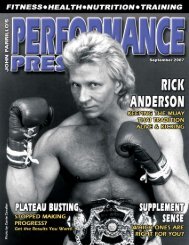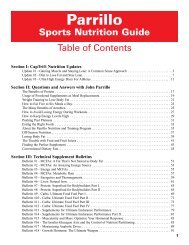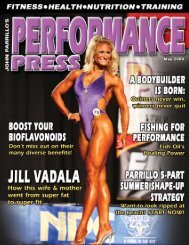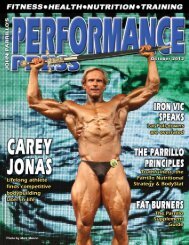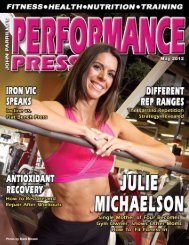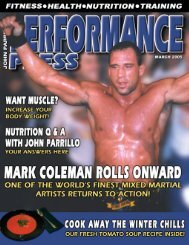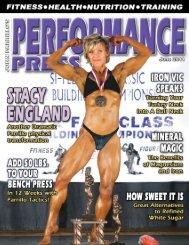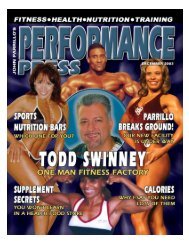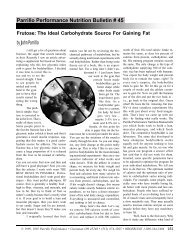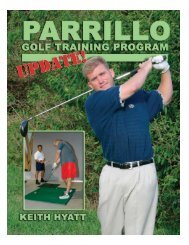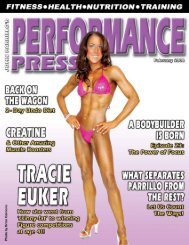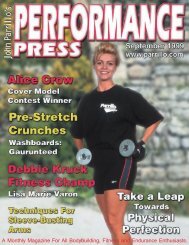A Monthly Magazine For All Bodybuilding, Fitness And - Parrillo ...
A Monthly Magazine For All Bodybuilding, Fitness And - Parrillo ...
A Monthly Magazine For All Bodybuilding, Fitness And - Parrillo ...
Create successful ePaper yourself
Turn your PDF publications into a flip-book with our unique Google optimized e-Paper software.
SHAPE UP IN TIME FOR THE SUMMER, PART II<br />
Although gaining muscle and losing fat at the same time is<br />
certainly possible (we see it happen all the time) it is not easy.<br />
There’s not much room for error. You have to do everything<br />
right and I strongly suggest you read The <strong>Parrillo</strong> Performance<br />
Nutrition Manual if you haven’t already. There is simply too<br />
much information for me to summarize it all in a short article like<br />
this. More important than how many calories you eat is, what<br />
kind of food do you eat? The Nutrition Manual has a detailed<br />
list of the foods you should be eating to build muscle and lose<br />
fat. The Manual also comes with a food composition guide and<br />
a food scale so you can precisely control your nutrient intake.<br />
To build muscle while stripping off fat you need to keep your<br />
protein intake high, carbohydrate intake moderate and fat intake<br />
low. You should increase protein intake and decrease carbohydrate<br />
intake, compared to the way you normally<br />
eat. A good rule of thumb would be to ingest<br />
one to two grams of protein<br />
per pound of<br />
bodyweight<br />
each day. Fat intake<br />
should be<br />
limited to 5-10%<br />
of calories. Unrefined,<br />
complex<br />
carbohydrates<br />
should be used to<br />
meet the remainder<br />
of your caloric requirement.<br />
I recommend<br />
that you keep<br />
your protein intake<br />
level and adjust your<br />
caloric intake by modulating<br />
the carbohydrates<br />
in your diet. Try<br />
and keep your body<br />
weight constant throughout<br />
the process.<br />
The <strong>Parrillo</strong> Bodystat Manual is an important part of<br />
tracking your fat loss and physique improvement. Having<br />
this done weekly insures that you will have a clear<br />
picture of what you are doing right and what you are<br />
doing wrong.<br />
The <strong>Parrillo</strong> Performance Body Stat Kit is an invaluable tool<br />
here. Following scale weight doesn’t tell you how much muscle<br />
you’ve gained or how much fat you’ve lost. Gaining ten pounds<br />
of muscle and losing ten pounds of fat will change your appearance<br />
and body composition dramatically, but your body weight<br />
will remain unchanged. The Body Stat Kit allows you to monitor<br />
body composition and this allows you to follow muscle gain<br />
and fat loss. The instruction manual that comes with it tells you<br />
exactly what to do to keep progress moving in the right direction.<br />
By increasing the protein-carbohydrate ratio in your diet,<br />
you’re supplying calories that are more prone to be stored as<br />
muscle than as fat. Also, by decreasing carbohydrate intake<br />
you induce hormonal and metabolic changes that encourages<br />
the use of stored body fat as fuel. Rely on lean protein sources<br />
such as skinless chicken or turkey breast, white fish and egg<br />
whites. Most people find it impossible to consume two grams of<br />
protein per pound of body weight each day from conventional<br />
foods. It’s simply too much food. This is where a high quality<br />
protein supplement is very useful. Our Optimized Whey Protein<br />
is an excellent choice here. It contains high levels of<br />
glutamine and the branched chain amino acids that help to<br />
maximize protein retention.<br />
In training you really have to go all out. You have to train<br />
hard and heavy to stimulate muscle growth. This means basic,<br />
heavy exercises giving 110%. When doing low rep work, concentrate<br />
on explosive contractions that generate a lot of power.<br />
In the higher rep ranges concentrate more on moving the weight<br />
slowly, especially during the concentric (lowering) phase of<br />
the contraction. “Time under tension” refers to the amount of<br />
time a muscle is under tension during a set. In a low rep set, the<br />
muscle gets worked very hard, but doesn’t spend much time<br />
under tension. Low rep sets are more intense and this is a very<br />
potent stimulus for growth. Time under tension is another<br />
important growth stimulator and<br />
you’ll need to do more reps at a<br />
slower pace, which will require<br />
the use of lighter weight. High rep<br />
sets should be carried to failure. I<br />
suspect you’ll find they’re more<br />
painful than the low rep sets. The<br />
combination of both training<br />
styles is very effective at stimulating<br />
muscle growth.<br />
Losing fat and gaining<br />
muscle at the same time can bring<br />
about rapid and dramatic changes<br />
in your appearance and body<br />
composition. It’s hard work. You<br />
have to be very strict on your diet<br />
and train harder than you normally<br />
do. As a rough guideline I<br />
would recommend weight training<br />
an hour a day, and possibly more,<br />
five or six days a week. Instead of<br />
worrying about over-training,<br />
worry about under-training. If anything<br />
you want to err on the side of over-training here. Occasional,<br />
brief periods of over-training can actually help break<br />
plateaus and stimulate new growth. Most people will need to<br />
do an hour of aerobics each day. If you have some stubborn<br />
fat that’s slow to come off, don’t be afraid to do more. Push<br />
yourself on your aerobics. You need to work hard enough to<br />
break a sweat and breathe hard. Any type of aerobic activity is<br />
acceptable however, just so you do it hard.<br />
Generally I wouldn’t recommend a program like this for<br />
more than eight or ten weeks at a time. It’s very intense and<br />
you’ll probably need a break after that long. With all training<br />
programs, you’ll eventually reach a plateau. After ten weeks<br />
on this program I’d suggest taking a break. Shift into a mode<br />
designed to gain muscle, as I discussed last month. Stay strict<br />
on your diet but eat a few more calories each day, say 300 more,<br />
than you have been. Reduce the aerobics down to 30 minutes<br />
a day. This will help you gain a pound or two of muscle. Train<br />
hard and good luck!<br />
Info-Line: 513•531•1311 John <strong>Parrillo</strong>’s Performance Press • June 2000 21



